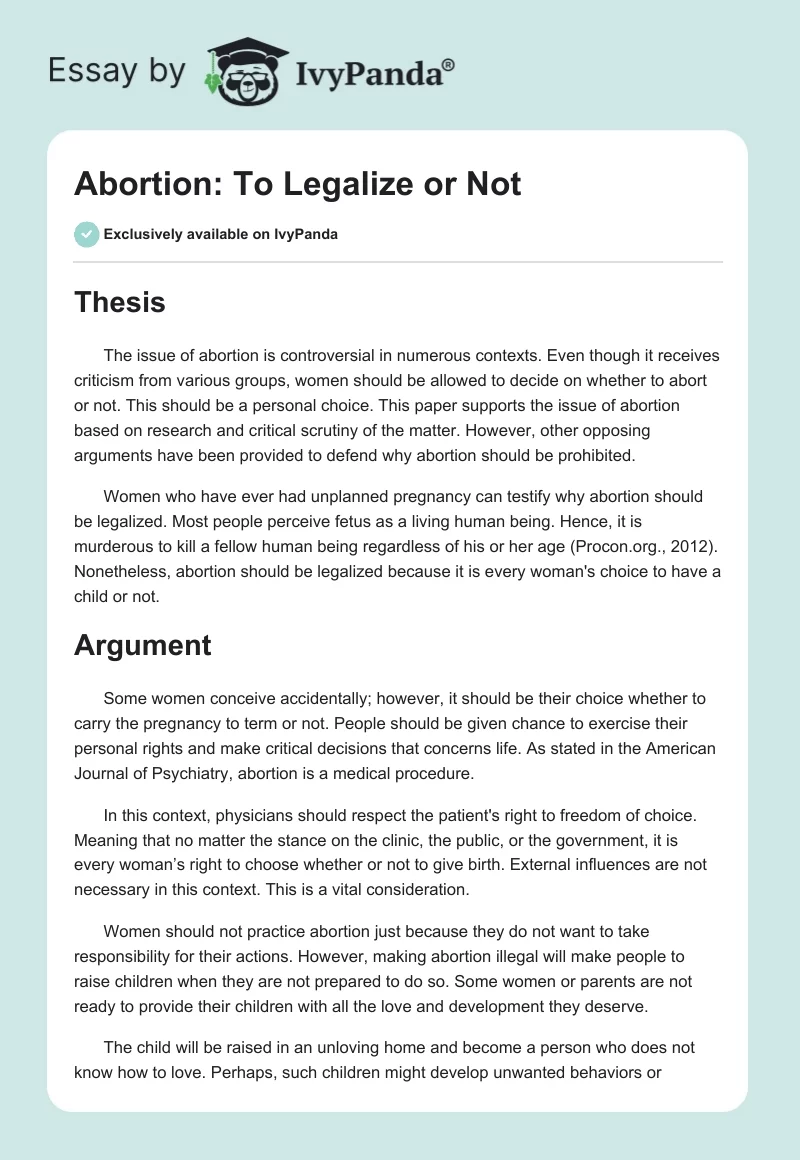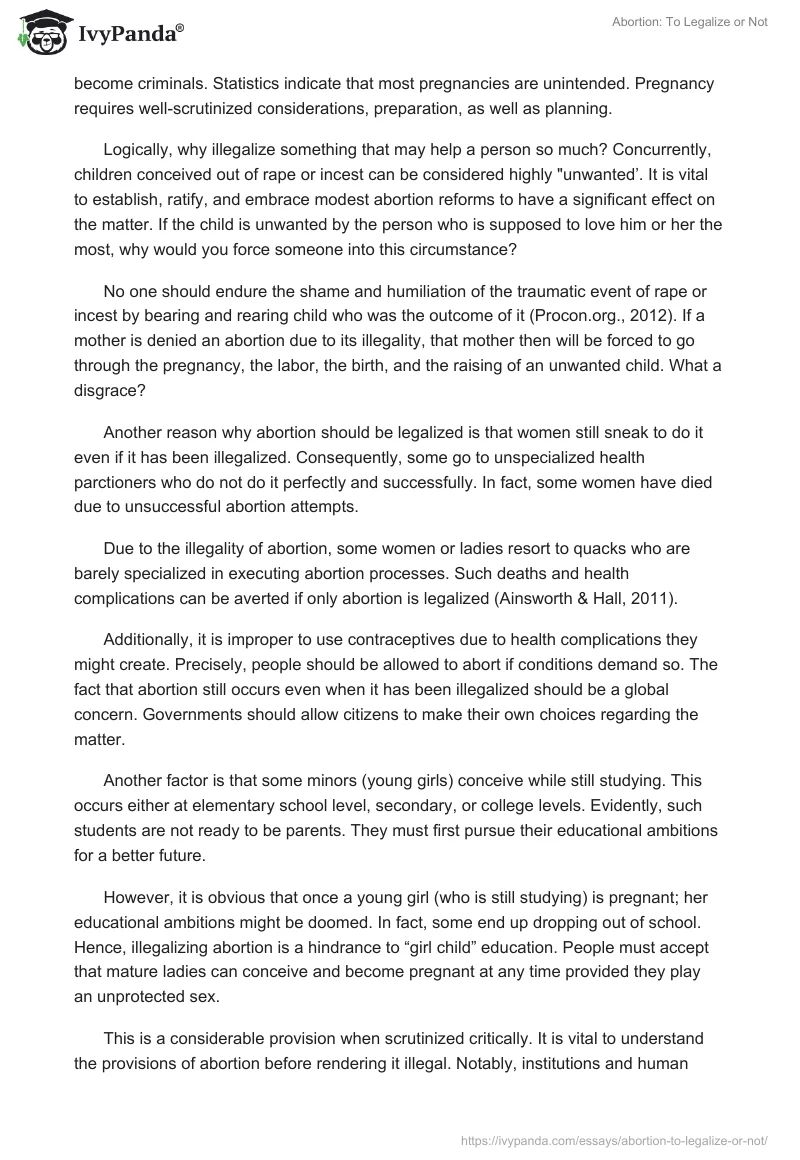Thesis
The issue of abortion is controversial in numerous contexts. Even though it receives criticism from various groups, women should be allowed to decide on whether to abort or not. This should be a personal choice. This paper supports the issue of abortion based on research and critical scrutiny of the matter. However, other opposing arguments have been provided to defend why abortion should be prohibited.
Women who have ever had unplanned pregnancy can testify why abortion should be legalized. Most people perceive fetus as a living human being. Hence, it is murderous to kill a fellow human being regardless of his or her age (Procon.org., 2012). Nonetheless, abortion should be legalized because it is every woman’s choice to have a child or not.
Argument
Some women conceive accidentally; however, it should be their choice whether to carry the pregnancy to term or not. People should be given chance to exercise their personal rights and make critical decisions that concerns life. As stated in the American Journal of Psychiatry, abortion is a medical procedure.
In this context, physicians should respect the patient’s right to freedom of choice. Meaning that no matter the stance on the clinic, the public, or the government, it is every woman’s right to choose whether or not to give birth. External influences are not necessary in this context. This is a vital consideration.
Women should not practice abortion just because they do not want to take responsibility for their actions. However, making abortion illegal will make people to raise children when they are not prepared to do so. Some women or parents are not ready to provide their children with all the love and development they deserve.
The child will be raised in an unloving home and become a person who does not know how to love. Perhaps, such children might develop unwanted behaviors or become criminals. Statistics indicate that most pregnancies are unintended. Pregnancy requires well-scrutinized considerations, preparation, as well as planning.
Logically, why illegalize something that may help a person so much? Concurrently, children conceived out of rape or incest can be considered highly “unwanted’. It is vital to establish, ratify, and embrace modest abortion reforms to have a significant effect on the matter. If the child is unwanted by the person who is supposed to love him or her the most, why would you force someone into this circumstance?
No one should endure the shame and humiliation of the traumatic event of rape or incest by bearing and rearing child who was the outcome of it (Procon.org., 2012). If a mother is denied an abortion due to its illegality, that mother then will be forced to go through the pregnancy, the labor, the birth, and the raising of an unwanted child. What a disgrace?
Another reason why abortion should be legalized is that women still sneak to do it even if it has been illegalized. Consequently, some go to unspecialized health parctioners who do not do it perfectly and successfully. In fact, some women have died due to unsuccessful abortion attempts.
Due to the illegality of abortion, some women or ladies resort to quacks who are barely specialized in executing abortion processes. Such deaths and health complications can be averted if only abortion is legalized (Ainsworth & Hall, 2011).
Additionally, it is improper to use contraceptives due to health complications they might create. Precisely, people should be allowed to abort if conditions demand so. The fact that abortion still occurs even when it has been illegalized should be a global concern. Governments should allow citizens to make their own choices regarding the matter.
Another factor is that some minors (young girls) conceive while still studying. This occurs either at elementary school level, secondary, or college levels. Evidently, such students are not ready to be parents. They must first pursue their educational ambitions for a better future.
However, it is obvious that once a young girl (who is still studying) is pregnant; her educational ambitions might be doomed. In fact, some end up dropping out of school. Hence, illegalizing abortion is a hindrance to “girl child” education. People must accept that mature ladies can conceive and become pregnant at any time provided they play an unprotected sex.
This is a considerable provision when scrutinized critically. It is vital to understand the provisions of abortion before rendering it illegal. Notably, institutions and human rights lobby groups are always fighting against birth control and abortions. However, it is vital to ask whether the “morning after pill” is included in this controversy?
Is it because the concerned ladies do not know that they are pregnant yet, or is this the reckless and careless behavior of a female? No one talks about this point; however, it is believable that if you can recklessly have sex and then take a “morning after pill” the following day, why not make that the illegal form of “birth control” (Weitz, 2010).. Abortion should be legalized in order to formalize the entire process.
Women should be at liberty to make choices on whether to carry a baby to term or not. After all, they are the ones who will be burdened by the entire pregnancy atrocities. Everybody needs a child and it is not anyone’s desire to kill; however, a situation might force.
Another argument why abortion should be legalized regards the health conditions of some women. One might conceive; however, her health status might not allow her to carry the baby to term. Either, she can die or undergo an acute miscarriage. This might interfere with her life despite the need to carry the pregnancy for the expected 9 months. Just think of the deaths that would occur if abortions were illegalized.
One would not only be killing the “child” but the mother also. Although the notion of women using contraceptives is a good one; however, not all women can afford contraceptives so often. So what happens when it comes to not being careless but being unable to afford the medical bill regarding maternity postnatal services?
Another validation for abortion is that it gives parents the right not give birth to children with health defects such as Down syndrome and cystic fibrosis. Anyway, why should parents have a child with these conditions? No parent or child should be forced to go through that. This is a considerable provision in the context of pregnancy and birth control. Motherhood should never be a punishment.
One should indulge in it when ready both psychologically and physically. Concurrently, abortion is usable as a population control method. If a person is not ready to have a child, both mentally and financially, having an unintended child can lead to numerous atrocities.
These incorporate malnutrition, lack of proper medical attention, poor educational services, and starvation. Precisely, one cannot provide sufficiently for the concerned child.
Counter-thesis and counter-argument
Abortion is illegal since it denies the fetus a chance to live. It is improper to legalize abortion as demanded previously. This is a transgression of the highest order. In fact, it is not only a crime but a murder also. It is advisable to carry pregnancy to term so as to bring forth a new life.
Additionally, abortion might kill the mother if not well executed. Hence, why should someone risk aborting a child in order to die in return? In fact, one should not engage in unprotected sex to get pregnant and abort in return. This is a considerable provision in various contexts. It is vital to agree that rearing unwanted children might be humiliating; nonetheless, it is improper to abort a life.
This is not only malicious but criminal in nature. Precisely, abortion should be illegalized in various contexts. Religious views such as the 6th commandment of the Old Testament (Thou shall not kill), plays a critical part in the views of pro-life representatives.
There are also thousands of deaths that stem from unsafe abortions that happen yearly as mentioned earlier. Abortion should be illegalized while women should be urged to use contraceptives as the recommended birth control measure.
Additionally, statistics has it that about 10% of the 1.6 million women experience cruel emotional ordeal after aborting (Cung, 2012). This is due to the fact that abortion causes various health complications to the concerned mothers. For instance, it is possible to experience damaged cervix, pierced uterus, hemorrhage, as well as other acute infections associated with the process.
Some mothers cannot even give birth again in the future. Another concern is that a baby can survive an abortion and this might be devastating to the mother. Concurrently, the baby might develop some deformities due to the attempted murder. Such incidences are difficult to handle.
In fact, there would not be the thousands of maternal deaths every year if abortions were legal and women were not afraid to get a safe and healthy abortion.
It is arguable whether those who abort should receive the same penalty that they give the baby (killing innocent beings). Abortion can also lead to the killing of future leaders. For instance, who knows what the aborted child would have been in case he or she was given a chance to live?
Response to counter-thesis
Agreeably, all arguments supporting the illegalization of abortion are obsolete and doomed. For example, there are modernized health facilities that can be used to carry out the entire process. This thwarts the fact that abortion can cause severe health complications. The most important thing is that abortion should be practiced in designated health facilities upon legalization.
The whole process can be done safely minus risking the mother’s life (Durand, 2009). Additionally, illegalizing abortion will not avert the vice absolutely. In fact, some women will slither to do it illegally, which is even worse. This is a considerable provision in various contexts. It is vital to agree that rearing unwanted children might be humiliating; nonetheless, it is improper to abort a life.
References
Ainsworth, S. & Hall, T. (2011). Abortion politics in congress: Strategic incrementalism and policy change. Cambridge: Cambridge University Press.
Cung, J. (2012). Abortion: Why it should be Illegal. Web.
Durand, J. (2009). The abortion: Before I formed you, I knew you. Bloomington, IN: AuthorHouse.
ProCon.org. (2012). Abortion. Web.
Weitz, T. (2010). Rethinking the Mantra that Abortion Should be Safe, Legal and Rare. Journal of Women’s History.161(1), 172,236.


